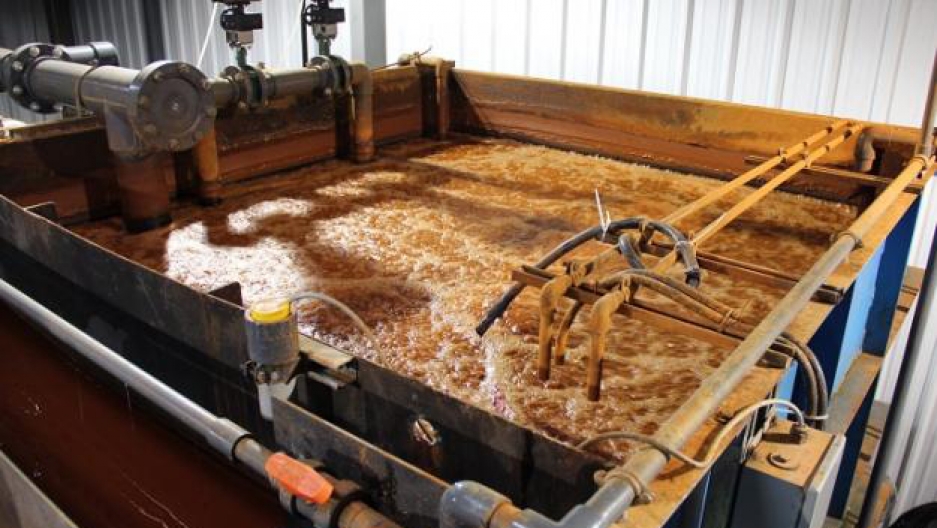Can fracking solve the problem of polluted mine water in Pennsylvania?
7-AMD-hottub AMD.jpg

Credit:
Reid R. Frazier
Iron colors the mine water red at the Blue Valley Abandoned Mine
Drainage Treatment Center. Money from gas company withdrawals is helping
keep the facility working.
One man’s trash is another man’s treasure — and that may be the case when it comes to water quality in Pennsylvania.
Now it appears that fracking might be one way to clean up this water — and some in the gas industry are pushing legislation to allow it.
Abandoned mine drainage, or AMD, has been a cause of water pollution in Pennsylvania for decades. The scale of the problem is simply enormous.
Back in 2005, Pennsylvania resident Bill Sabatose took some citizen action: he helped start the Toby Creek Watershed Association, a local group that built and now runs a water-treatment facility in the northwestern part of the state.
After passing through Sabatose’s facility, dirty, rust-colored, toxin-filled water from nearby creeks and streams flows clear into tanks about the size of an above-ground pool.
In one of these tanks, they’re raising brown trout.
“A lot of people just love to come up here and look at them,” Sabatose says. “I guess it mesmerizes them. The [tanks] just look like a big aquarium.”
The fish will be used to stock streams around the state. The clean water eventually runs into the Brandy Camp Creek, a tributary of the Allegheny River.
Sabatose grew up here, near the town of Brockway. The region has a long mining history. The streams all used to be the color of rust.
“There wasn’t a fish within 100 miles of this place, so it was pretty bad,” he says.
Since the group built this treatment plant, with the aid of a state grant, the Brandy Camp started getting cleaner. But there was a problem. The watershed group had no idea how it would pay to keep the plant running.
Then around five years ago, a potential solution emerged: fracking. Drillers use millions of gallons of water, along with sand and chemicals, to frack natural gas out of underground rock formations. Frackers typically use freshwater, but a few companies approached Sabatose with an idea: could they use his cleaned up mine water?
“Well, I thought, ‘There’s all this water, and I need more money to treat all of it.’" Sabatose says. "So I said ‘Try it‘ — and they tried it.” And it worked.
The gas companies paid Sabatose’s group for the water — though technically it’s a donation — and with the money, the group could treat more abandoned mine drainage.
Pennsylvania water regulators, faced with a $15 billion abandoned mine problem, want to see more of this. They see it as one way to get AMD out of streams by putting it into fracked wells. Some drilling companies have already started doing it, but others are balking.
Andrew Paterson of the Marcellus Shale Coalition say the issue is liability. The problem is the “You touch it, you own it” concept,” he says. Drillers are worried that they’d be held liable for the condition of the abandoned mine in perpetuity, even if they only used the water for a few months.
“It’s not clear on either a state or federal basis that if you were to use that water ... you have not inherited the longterm treatment of that source of water,” Paterson explains.
Non-profits watershed groups like Sabatose’s don’t have to worry about this: state law protects them from lawsuits over the mine water they treat, because they’re considered Good Samaritans. Now a bill being pushed by the gas industry and the state’s Department of Environmental Protection would add gas companies to that list of Good Samaritans.
Not everyone thinks this is such a good idea.
“We see this as a 'lose-lose-lose,'" says Tracy Carluccio of Delaware Riverkeeper, an environmental group. She says gas companies are not Good Samaritans. Under the bill, companies wouldn’t be required to clean up the mine water before using it or buy it from groups like Sabatose’s: they could simply withdraw the water they need from a polluted mine.
“They’re not cleaning it up,” she says. “They’re taking very polluted fluids and making them more polluted.”
But some see this as a way to peck away at the state's historic abandoned mine water problem. Radisav Vidic, an engineer at the University of Pittsburgh, says allowing frackers to use mine water keeps that water from polluting the rivers.
“If you think about it, AMD is already killing fish in the streams,” he says. “If you take it out and prevent it from going into the streams, or if you clean it up before it goes into the streams, you can only make it better.”
Even if the bill passes, no one is promising that fracking could solve the state’s abandoned mine water problems. At current funding levels, cleanup of the thousands of historic coal mines in Pennsylvania is projected to take up to 50 years.
Reid Frazier, from the Pennsylvania public radio program the Allegheny Front, reported this story. This story comes by way of PRI's Living on Earth.

No comments:
Post a Comment